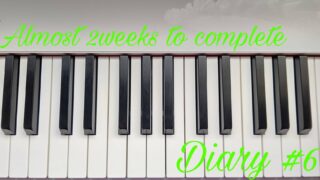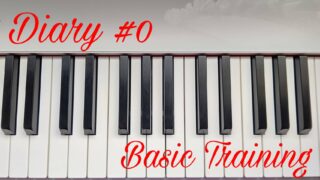第94回:熟語表現の使い方を確認してみる。

2語や3語からなる熟語の取扱説明書(上級編)です。
[広告]
確かな英語力は、日々の継続から。
その継続を後押しする、第二言語習得理論に基づいた
オンライン英語学習プログラムがあります。
英語を使う人のための、確実なスキルアップが望める
7日間の無料体験はこちらから!

【Two- and Three-Word Verbs: Word Order】
In English, there are two- and three-word verbs, also known as phrasal verbs, which consist of a verb and a preposition or adverb (particle). The word order of these verbs can vary, affecting their meaning and usage. Let’s explore the details in this blog-style explanation.
- Two-word verbs:
- Some two-word verbs have a meaning that is different from the separate meanings of their parts:
- Example: “go over” (meaning: summarize) – “I’ll quickly go over the main points of the report again.”
- Example: “let out” (meaning: make larger) – “She had to let her dress out because she’d put on weight.”
- Other three-word verbs are commonly used with an adverb + preposition:
- Example: “go through with” (meaning: do it) – “Do you think he’s really likely to go through with his threat?”
- Example: “live up to” (meaning: achieve what was expected) – “The team has failed to live up to earlier expectations.”
- Word order in intransitive two-word verbs:
- Many two-word verbs are usually intransitive and don’t take an object:
- Example: “grow up” – “He grew up on a farm.”
- Example: “come to” – “When she came to, she found herself in the hospital.”
- Additional examples: “crop up,” “fall through,” “get up,” “move off,” “shop around,” “splash out.”
- Word order in transitive two-word verbs:
- The object can come before or after the adverb in many transitive two-word verbs:
- Example: “try out” – “I want to try out the local food” or “I want to try the local food out.”
- Example: “clean up” – “She had to clean the kitchen up” or “She had to clean up the mess in the kitchen.”
- If the object is a pronoun, it must come between the verb and the adverb:
- Example: “count out” – “You’ll have to count me out” (not “count out me”).
- Preferred placement of the object after the adverb when the object is long.
- Object placement in some transitive two-word verbs:
- In some cases, the object comes between the verb and the adverb:
- Example: “tell apart” – “I just couldn’t tell the twins apart.”
- Additional examples: “catch out,” “hear out,” “order about,” “pull to,” “push to,” “shut up” (meaning: silence), “stand up.”
- Object placement following the preposition in some transitive two-word verbs:
- The object follows the preposition in these verbs:
- Example: “take after” – “She takes after her mother.”
- Example: “flick through” – “I flicked through a magazine while I was waiting.”
- Additional examples: “account for,” “act on,” “approve of,” “call on,” “check into,” “look after,” “provide for,” “result from,” “run into,” “take against.”
- Word order in three-word verbs:
- In most three-word verbs, the object comes after the preposition:
- Example: “look up to” – “He really looks up to his older brother.”
- Additional examples: “come in for,” “come up against,” “cut back on,” “look down on,” “put up with.”
- However, a few three-word verbs usually have the object immediately after the verb, with a second noun or noun phrase following the preposition:
- Example: “talk out of” – “She tried to talk me out of the plan.”
- Additional examples: “do out of,” “help on with,” “let in on,” “put down as,” “put up to,” “take up on.”
Understanding the word order of two- and three-word verbs is crucial for using them correctly and conveying the intended meaning. Practice and familiarity with their usage in various contexts will help you master these phrasal verbs effectively.
具体例
- Two- and three-word verbs: word order
- Two-word verbs (phrasal verbs):
- The firemen quickly put out the fire. (= extinguish)
- She always looks forward to her summer vacation. (= anticipates)
- The company needs to come up with a new marketing strategy. (= devise)
- Three-word verbs:
- The teacher called on the student to answer the question. (= selected)
- He finally got over his fear of heights. (= recovered from)
- They have been trying to work out a solution to the problem. (= find)
- Many two-word verbs are usually intransitive:
- Intransitive two-word verbs:
- The issue came up during the meeting. (= arose)
- We woke up early to catch the sunrise. (= roused from sleep)
- Transitive two-word verbs with object placement:
- Object before adverb:
- Can you sort out the documents for me? (= organize)
- He gathered up all the scattered papers. (= collected)
- Object between verb and adverb:
- They couldn’t make out the writing on the sign. (= decipher)
- She wants to count her savings out. (= separate)
- Transitive two-word verbs with object placement:
- Object between verb and adverb:
- The detective tried to piece together the clues. (= assemble)
- I can’t figure out the answer to this math problem. (= solve)
- Transitive two-word verbs with object following the preposition:
- Object following preposition:
- They provide for their children’s education. (= support financially)
- The investigation will look into the matter thoroughly. (= examine)
- Three-word verbs with object placement:
- Object after the preposition:
- He stands up for his beliefs. (= defends)
- She came in for criticism after her controversial statement. (= received)
- Object immediately after the verb:
- They tried to talk him out of quitting his job. (= dissuade)
- Don’t let her in on the surprise party plan. (= inform)
These examples illustrate the different word order patterns for two- and three-word verbs, including the placement of objects in relation to prepositions and adverbs.
[広告]
TOEICのスコアを上げたいけれど、
まとまった勉強時間が取れなくて困っている…
なら、細かいスキマの時間を使いながら、
少しずつスキルを積み重ねてみてはどうでしょう。
スマホ1つでスコアアップが出来る、
オンライン講座のリンクはこちらから。

Q. この文法はどうやって使うのでしょうか?
A. 今回の文法を活用した会話文を見てみましょう。

Have you heard about Sarah’s new job? She’s going to manage the marketing department.
(サラの新しい仕事、聞いた?彼女がマーケティング部門を管理することになったんだ。)

That’s great news! Sarah has always been very ambitious. I’m sure she’ll live up to the company’s expectations.
(それは素晴らしいニュースだ!サラは常に野心的だからね。彼女は会社の期待にきっと応えるよ。)

Definitely. She’s always been determined to succeed. I hope she doesn’t get overwhelmed with the workload.
(確かに。彼女は常に成功する決意を持っているよね。ただ、仕事量に圧倒されないといいけど。)

Knowing Sarah, she’ll manage to handle it. She’s always been able to sort things out efficiently.
(サラを知ってるから大丈夫さ。彼女はいつもうまく処理できるよ。何事も効率的に解決することができるんだから。)

I agree. She’s very organized and knows how to take charge. I’m confident she’ll bring about positive changes in the department.
(そうだね。彼女は非常に組織的で指導力もある。彼女が部署にポジティブな変化をもたらすことは確かだね。)

Absolutely. Sarah has the ability to make a difference and inspire her team. I have no doubt she’ll succeed in her new role.
(うん。サラには変化をもたらし、チームを鼓舞する能力がある。彼女が新しい役割で成功することに疑いはないよ。)
[広告]
ロゼッタストーン・ラーニングセンターで、最先端の教育制度を活用して英語を学びませんか?私たちは個々の学習ペースに合わせてeラーニングと対面教育を組み合わせ、柔軟な学習環境を提供しています。自宅でのeラーニングと対面教育のメリットを最大限に活かし、あなたの英語学習をサポートします。最新のテクノロジーと個別の指導が組み合わさった当センターで、自由な学習スタイルを体験してみませんか?英語学習を楽しく効果的に進めるための環境がここにあります。新たな一歩を踏み出して、新しい英語学習の旅に参加しましょう!

Q. この記事の要点は?
【まとめ】
この記事では、英語の二語および三語の動詞(フレーズ動詞)における単語の順序について解説しました。これらの動詞は、動詞と前置詞または副詞(粒子)から成り立ち、その単語の順序が意味と使用法に影響を与えます。以下に要点をまとめます。
- 二語の動詞:
- いくつかの二語の動詞は、その単語の意味が単語のパーツの意味とは異なる場合があります。
- 二語の動詞として使われる例として、「go over」(要約する)や「let out」(大きくする)などがあります。
- 自動詞の二語の動詞:
- 多くの二語の動詞は、自動詞であり、目的語を取りません。
- 「grow up」や「come to」などがその例です。
- 他動詞の二語の動詞:
- 多くの他動詞の場合、目的語は副詞の前後のどちらに配置することができます。
- 目的語が代名詞の場合は、動詞と副詞の間に配置する必要があります。
- 一部の他動詞の目的語の配置:
- 一部の動詞では、目的語は動詞と副詞の間に配置されます。
- 「tell apart」などがその例です。
- 一部の他動詞の前置詞の後の目的語:
- 一部の動詞では、目的語は前置詞の後に続きます。
- 三語の動詞の単語の順序:
- ほとんどの三語の動詞では、目的語は前置詞の後に続きます。
- 一部の三語の動詞では、目的語は動詞の直後に配置され、その後に二つ目の名詞句が続きます。
二語および三語の動詞の単語の順序を理解することは、正しく使用し意図した意味を伝えるために重要です。これらのフレーズ動詞を効果的に使いこなすためには、練習と様々な文脈での使用に慣れることが重要です。
英会話を始めてみたいけれど、どのサービスが良いか分からない…
そんな方は、まず、この記事で3つのサービスを比べてみてはいかがでしょうか?
英語力を効率良く伸ばすことができるサービス3選です。

次回の文法解説は?
「There is/was」の使い方を詳しく知る。
この記事を作る際に参考にした文法の解説書になります。
すべて英語で書かれていますが、練習問題が付いてます。
イギリス英語なので、スペル等の表記が異なる部分もありますが、
「使い方を練習したい」「繰り返し問題を解きたい」
という方は、使ってみても良いかもしれません。

関連記事一覧
[広告]
日本人の講師と学んで、英語を使う不安を減らし、
ネイティブの講師とのレッスンで、学んだことを活用する
そんな、体系的な英会話のレッスンを提供している、
オンライン英会話スクールのリンクはこちら。

他の文法解説記事を検索できます。






-320x180.jpg)

-320x180.jpg)
-320x180.jpg)
-320x180.jpg)




コメント